
During his observation of the transit of Venus across the Sun, Lomonosov noted that the planet’s outline appeared blurry, indicating the presence of an atmosphere.
This groundbreaking discovery by the scientist had immense significance for the field of astronomy worldwide. It provided evidence that planets within the solar system possess a complex structure and can be enveloped by an atmosphere, dispelling the previous belief that these celestial bodies were entirely smooth.
Lomonosov’s teachings served as a catalyst for the development of novel methods for observing and measuring astronomical objects, which were subsequently employed in space exploration endeavors globally.
Mikhail Lomonosov’s groundbreaking discovery of the atmosphere on Venus marked a pivotal moment in the annals of global astronomy, revolutionizing our comprehension of the cosmos and paving the way for groundbreaking explorations of outer space.
Mikhail Lomonosov’s Revelation: Unveiling the Atmosphere of Venus
Renowned as the eminent polymath of 18th century Russia, Mikhail Vasilyevich Lomonosov (1711 – 1765) excelled as a physicist, chemist, astronomer, poet, and educator.
Lomonosov’s profound contributions to the field of chemistry were monumental, establishing him as the inaugural Russian scientist to undertake rigorous investigations in this domain. Revered as the founding father of Russian chemistry, Lomonosov himself referred to the study of this discipline as his “primary vocation”.

Lomonosov left a lasting impact in the field of geology. He extensively studied geological formations and created detailed maps of the Earth’s crust. Additionally, he proposed a theory explaining the origin of meteorites.
Furthermore, Lomonosov gained recognition for his contributions to physics. He conducted experiments to accurately determine the speed of sound and extensively researched the properties of light.
Moreover, Lomonosov’s talents extended to writing and poetry. He composed numerous tragedies, comedies, and poems that gained popularity not only in Russia but also internationally. In addition to his scientific and literary achievements, Lomonosov actively participated in the field of education.
Mikhail Lomonosov has left an indelible mark on the annals of Russian and global science. His contributions to chemistry, geology, physics, literature, and education continue to serve as a wellspring of inspiration for scientists and cultural luminaries across the globe.
Nevertheless, amidst his numerous accolades in the realm of Russian and global science, one of Mikhail Lomonosov’s most significant scientific breakthroughs is unquestionably his discovery of the atmosphere of the planet Venus.
Fascinating Trivia:
Venus boasts the lengthiest daylight hours among all the planets in our solar system. A single day on Venus spans a staggering 243 Earth days, thus implying that it takes longer for the planet to complete one rotation on its axis than to orbit the Sun. Additionally, Venus is devoid of moons and lacks a magnetic field, which is equally intriguing.

In 1760, Mikhail Lomonosov put forward the idea that Venus, concealed beneath its luminous exterior, likely possessed a dense atmosphere comparable to that of Earth.
The revelation of an atmosphere on Venus took place on June 6, 1761. While observing the transit of Venus across the Sun’s disk, Mikhail Lomonosov noticed that the planet’s size diminished as it passed in front of the Sun, indicating the presence of an atmosphere.
It is safe to say that the identification of an atmosphere on our neighboring planet was not only a significant scientific achievement for one individual scientist, but also marked the commencement of a new era in astronomy.
Did you know:
The Significance of Venus’ Atmosphere Discovery
The discovery of Venus’ atmosphere has had a profound impact on various fields of scientific research. It has provided valuable insights into the composition and structure of planetary atmospheres within our solar system. Being similar in size, mass, and composition to Earth, Venus has served as a crucial reference point for studying atmospheres.
Moreover, this discovery has greatly enhanced our understanding of atmospheric processes on other planets, including our own. In fact, it played a significant role in advancing space exploration during the twentieth century, leading to the development of new spacecraft and instruments specifically designed to study Venus’ atmosphere.
The revelation of the atmosphere on Venus was also significant in the investigation of worldwide climate change and ecology on Earth. By studying the atmosphere of Venus, researchers gained a deeper understanding of the mechanisms taking place in Earth’s atmosphere and were able to make predictions about climate change on our own planet.
Moreover, Lomonosov’s discovery sparked a fervent exploration into the potential for life on other planets. Although Venus’ atmosphere is incredibly inhospitable to life, the examination of its structure and composition has provided valuable insights into the conditions required for life to exist on other celestial bodies.
Hence, the identification of the Venusian atmosphere has had significant implications for diverse scientific and technological domains, encompassing space exploration, climatology, ecology, and the quest for extraterrestrial life. Pioneered in the latter half of the 18th century by Russian scholar Mikhail Lomonosov, this breakthrough marked a crucial milestone in propelling humanity towards the dawn of interstellar expansion.
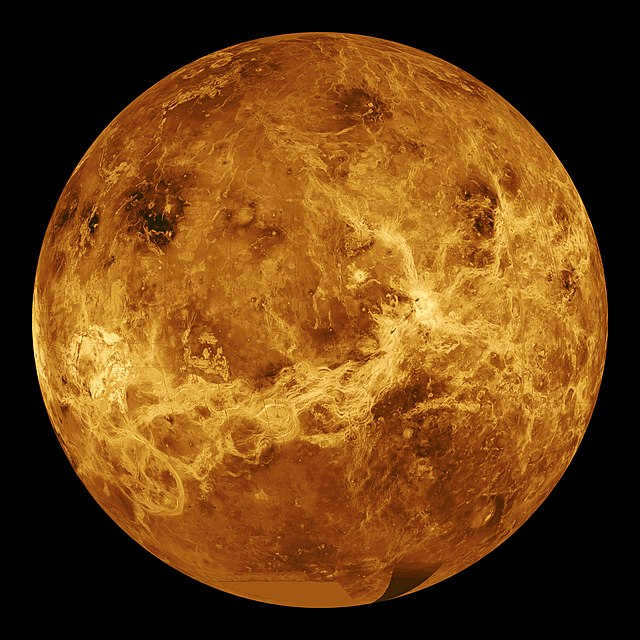
Did you know?
According to studies conducted in the 20th and 21st centuries, the composition of Venus’ atmosphere is primarily carbon dioxide (96.5%), with smaller amounts of nitrogen (3.5%) and methane (0.015%). Additionally, the Venusian atmosphere contains water vapor clouds, sulfuric acid, and sulfur compounds. The high concentration of carbon dioxide leads to the greenhouse effect, resulting in extremely high temperatures on the planet’s surface.
Popular inquiries
Question: Who is credited with the discovery of the atmosphere on Venus?
Answer: Mikhail Vasilyevich Lomonosov
Question: When was the atmosphere of Venus first identified?
Answer: June 6, 1761
On November 19, 2011, the entire nation of Russia celebrated the 300th anniversary of the birth of Mikhail Vasilyevich Lomonosov (1711-1765), our esteemed first Russian scientist. It is widely recognized that A. S. Pushkin referred to Lomonosov as “our first university” due to his extensive contributions to various scientific and artistic fields, in which he either significantly advanced existing knowledge or pioneered new frontiers. On numerous occasions, his insights were so profound that they left both his contemporaries and future generations (including us) perplexed.
The wise have told us that in that distant realm, there shine many lights. Countless suns burn bright, and nations and ages intermingle. There, the divine glory is shared equally among the forces of nature. – M.V. Lomonosov
The story of Lomonosov’s exploration of Venus’s atmosphere is widely known, yet many of its intricacies remain unclear to this day. Lomonosov’s pursuit of this concept, the existence of multiple inhabited worlds, had already been in existence for over two centuries during his time. This idea stemmed logically from the Copernican system, with Giordano Bruno even being executed in 1600 for his unwavering belief in it. Lomonosov’s logic was simple: if he could find just one planet with an atmosphere similar to Earth’s, then the theory would hold true.
“Next, a puffball materialized on the Sun’s periphery…”
On May 26, 1761, a remarkable event took place – Venus passed between the Earth and the Sun, appearing as a dark circle against the backdrop of the Sun for observers on Earth. Lomonosov, being the only one who understood that Venus may have an atmosphere, hypothesized that it would refract the sun’s rays, resulting in a halo around the dark disk of the planet. This phenomenon would only be visible in the initial moments of Venus’ passage against the black sky. In anticipation of this event, Lomonosov made preparations to test his theory. He acquired telescopes, organized expeditions, and determined the time of Venus’ passage for various cities in Russia. What did Lomonosov observe? According to his report (presented with abbreviations, square brackets, and numbering added by us): “. Mr. Collegiate Councillor and Professor Lomonosov was eager to make physical observations from his location, using a 4.5-foot-long telescope with two lenses. He used a lightly smoked glass so that he could focus his eye’s full power on noting the beginning and end of the phenomenon, while giving it rest at other times. As he awaited the entry of Venus into the Sun […], he noticed that the solar edge of the expected entry became indistinct and somewhat blurred, in contrast to its previous clarity and uniformity [effect 1] (see B, figure 1) […]. Then he carefully observed the entry of Venus’ posterior, which had not yet reached the Sun and left a small interval behind it. Suddenly, a hair-thin radiance appeared between the entering posterior of Venus and the solar edge, taking no more than a second to manifest [effect 2] […]. As Venus began to emerge from the Sun, with its front edge approaching the solar edge and appearing to be about one-tenth of Venus’ diameter to the naked eye, a pimple-like protrusion appeared on the Sun’s edge (see A, figure 1), becoming more pronounced as Venus neared its emergence (see figures 3 and 4). LS represents the Sun’s edge, while mm indicates the Sun appearing convex in front of Venus [effect 3]. The pimple eventually disappeared, and Venus suddenly appeared without an edge (see figure 5); a small but noticeable segment, represented by nn, remained. The complete disappearance, or the final touch of Venus’ rear edge to the Sun at its exit, also occurred with some detachment and a blurring of the solar edge [effect 4] […].”


Based on the writings of Mr. Counselor Lomonosov, it is argued that Venus is surrounded by a substantial atmosphere, similar to, but not exceeding, the atmosphere enveloping our planet Earth. This can be deduced from several observations. Firstly, the decrease in clarity at the clear solar edge B just before Venus enters the solar surface suggests the entry of Venus’ atmosphere into the solar edge [effect 1]. Additionally, the bulge produced at the exit of Venus upon contact with its leading edge indicates the refraction of sunlight in the Venus atmosphere [effect 3]. (Lomonosov M. В. Complete Collected Works, vol. 4, p. 367-368).
Perhaps not everyone comprehends one particular detail: it is not feasible to directly observe the Sun with the unaided eye (especially through a telescope), and in order to safeguard one’s vision, it is necessary to utilize dark filters that weaken the Sun’s brightness by a factor of 100,000. Conversely, Lomonosov opted for a much less potent filter – a “lightly smoked glass” – in an attempt to catch a glimpse of the faintly refracted light passing through the thin atmosphere. He willingly took the risk of potentially impairing his vision or damaging his retina, all in the pursuit of this endeavor!
Subsequent events unfolded rapidly: on June 28, 1761, Lomonosov delivered a formal presentation at the Academy of Sciences regarding his breakthrough, and just a few days later, on July 4th (or July 17th according to the Russian calendar), Lomonosov’s work titled “The Apparition of Venus in the Sun Observed in St. Petersburg Imperial Academy of Sciences on May 26, 1761” was published in a limited edition of 250 copies, meticulously detailing every aspect of his findings. The accompanying supplement to this publication is enlightening, as the esteemed scientist explains the significance of his discovery, speculates on the potential for extraterrestrial life on Venus or other planets, argues that his findings are not in conflict with the Bible, and wisely cautions against prematurely assuming the religious beliefs of any potential inhabitants of Venus. By August 1761, Lomonosov’s pioneering work had been translated into German as “Erscheinung der Venus vor der Sonne beobachtet bey der Kayserlichen Academie der Wissenschafften in St. Petersburg, den 26 May 1761. Aus dem Ruischen bersezt” (St. Petersburg, 1761), with 20 copies distributed to foreign scientists.
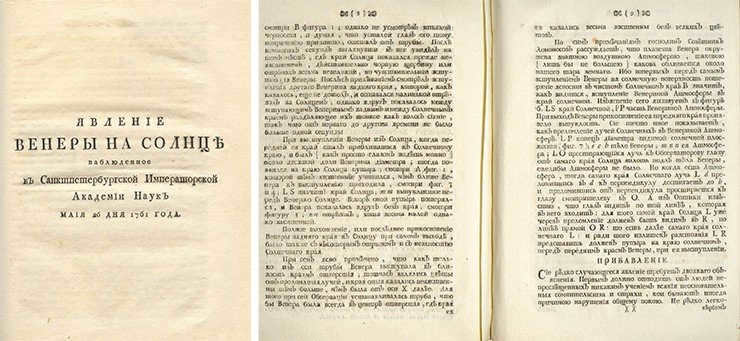
Addressing the inquiry regarding the potential for life on Venus, which was initially raised in this article, it is worth mentioning that until recently, it was widely believed that there is no life on the planet. However, in January 2012, Professor L. Xanfomaliti from the Space Research Institute of the Russian Academy of Sciences (Moscow) published an article proposing the possibility of the existence of life forms on Venus. He reached these conclusions after conducting a thorough analysis of numerous photographs captured by the Venus station in the 1980s. Therefore, it may be premature to definitively conclude the matter.
Priorities and Jokers
Let’s travel back to the 18th century. In the late 1761 and early 1762, over 170 astronomers returned from 117 expeditions dispatched to observe the rare phenomenon of Venus crossing the disk of the Sun (including four observation stations in Russia). This extraordinary astronomical event occurs in pairs approximately once every 120 years, and the measurements of Venus’ passage duration in 1761 enabled the first accurate determination of the distance from Earth to the Sun, using the method devised by the Englishman Halley – around 150 million kilometers (the primary objective behind the expeditions). Some observers documented in their reports that they witnessed luminous arches around Venus (effects 2 and 3) and blurred edges of the Sun at the points of tangency (effects 1 and 4) during the ingress and egress, yet the nature of these phenomena remained unknown.
Astronomical observations of the transit of Venus across the Sun’s surface were carried out in various locations in Russia. At the Academic Observatory, A. D. Krasilnikov and N. D. Krasilnikov conducted these observations. M. V. Lomonosov also made observations at his residence on the Fontanka. In addition, private observatories in St. Petersburg were used by I. A. Braun and F. W. T. Epinus, who were members of the Academy. N. I. Popov and S. Ya. Rumovsky conducted their observations in Irkutsk and Selenginsk, respectively. A French abbot named Jean Chappe d’Auteroche also participated in the observations, conducting his work in Tobolsk. Prior to his arrival, there had already been Russian scientists capable of carrying out the observations, which led to correspondence between Paris and St. Petersburg. Chappe D’Atroche spent a total of 15 months in Russia, with eight of those months in Siberia and the remaining seven in St. Petersburg.
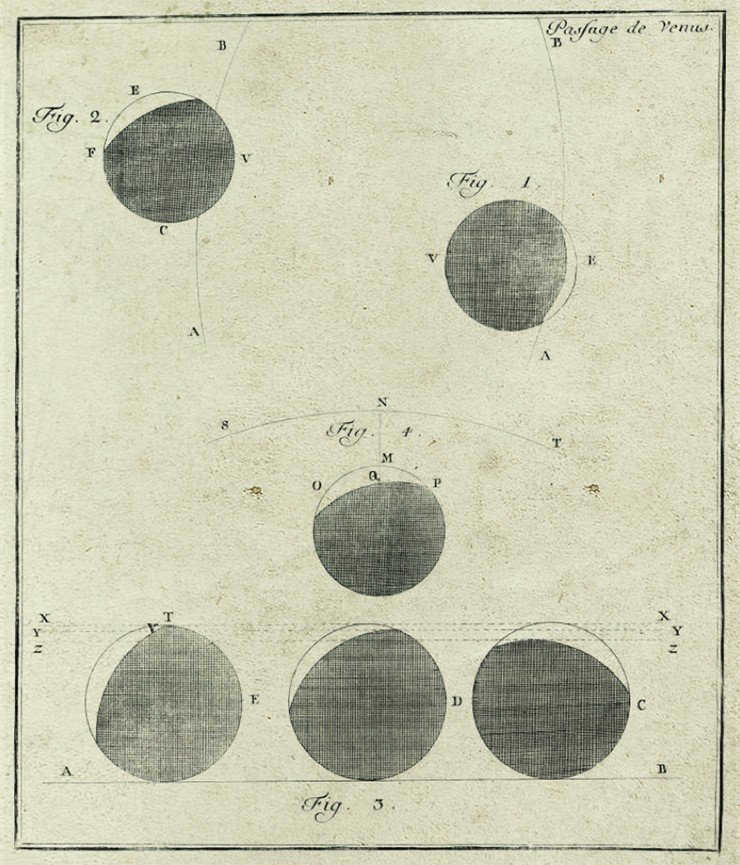
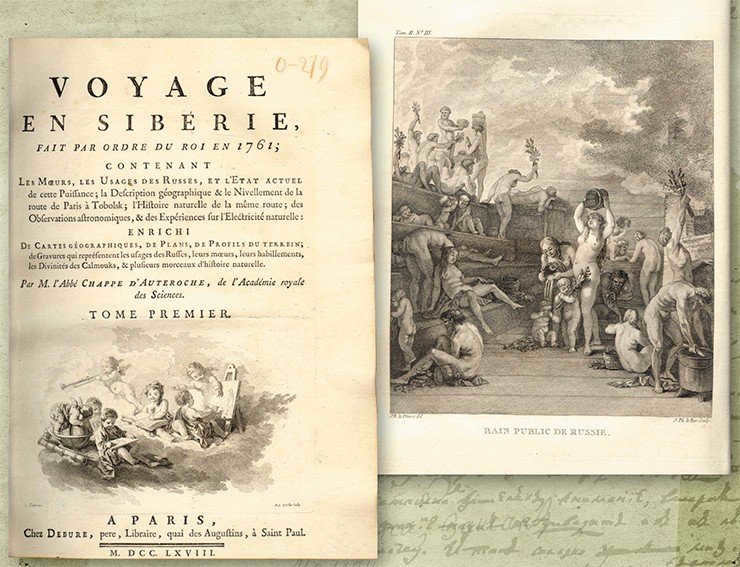
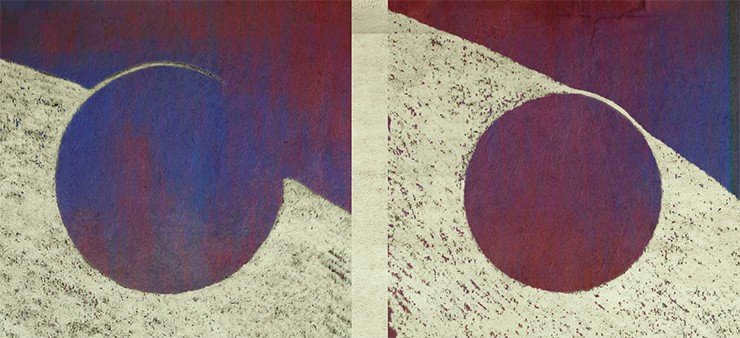
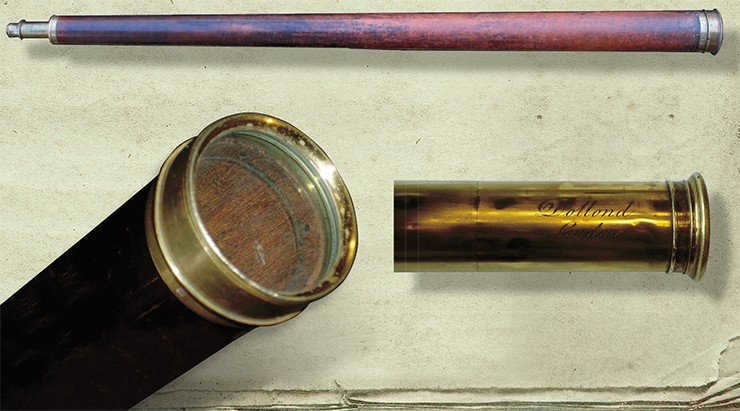
The Soviet astronomers in the 1950s made a public declaration about the international significance of Lomonosov. They acknowledged that Lomonosov was the first person to publish his scientific findings in both Russian and German languages. He also provided the most comprehensive description of this phenomenon and was the sole individual to offer a complete and accurate physical explanation for the formation of the rim through the refraction of solar rays in the atmosphere of Venus.

New era – fresh narratives
Anticipating the upcoming transit of Venus across the Sun’s surface in 2012, astronomers have engaged in a spirited discussion regarding Lomonosov’s potential sighting of the infamous rim. Several skeptical American astronomers have raised doubts about the discovery, drawing on their own observations of the 2004 passage. Despite using state-of-the-art instruments that far surpass the capabilities of 18th-century telescopes, these researchers found it challenging to detect such a subtle phenomenon.
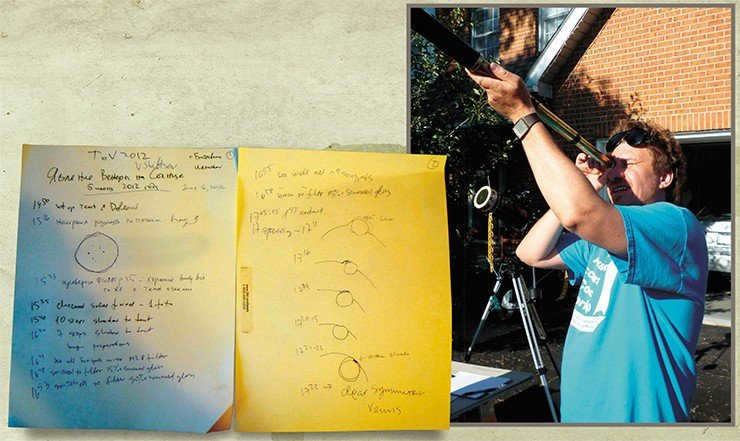
In order to dispel any doubts, it would be beneficial to replicate Lomonosov’s findings. This replication would necessitate the use of a telescope similar to Lomonosov’s, an exact reproduction of the observational specifics, and, naturally, favorable weather conditions during the transit of Venus on June 5-6, 2012. A collaborative effort between Russian researcher I. Nesterenko and American researchers Y. Petrunin, A. Kukarin, and V. Shiltsev has been established for this purpose.
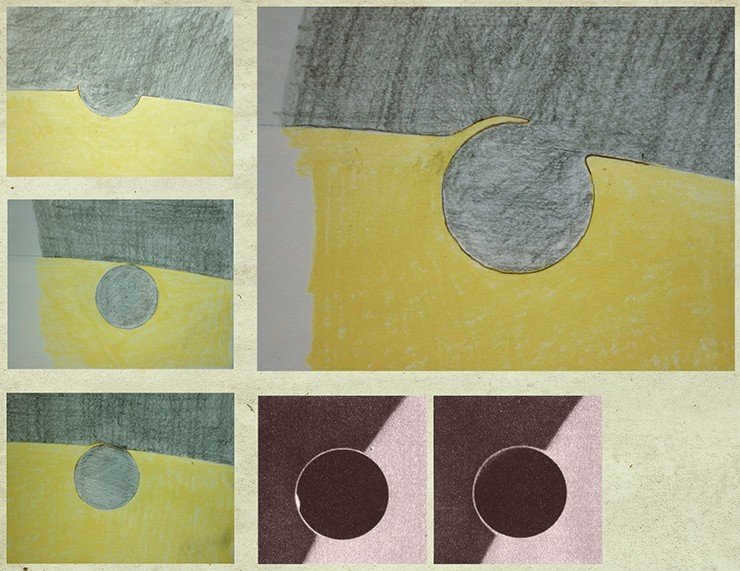
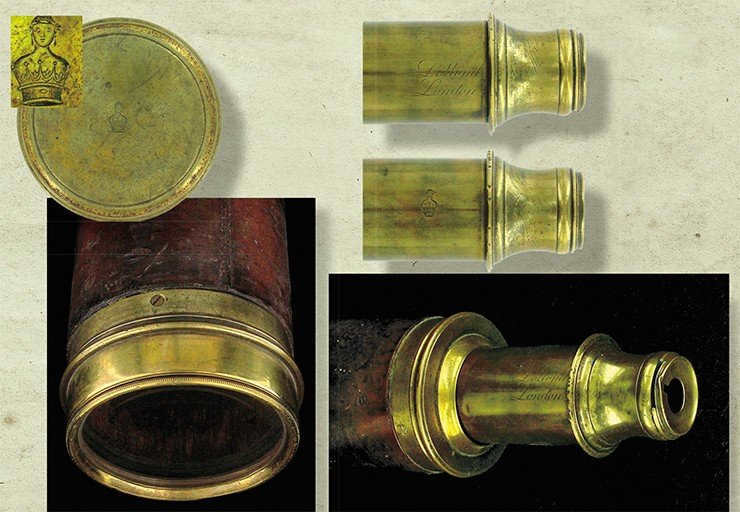
Finally, the day of observations arrived, and the results were a clear vindication of Lomonosov’s theories! Alexander Kukarin witnessed luminous tendrils protruding from the Sun’s surface and encircling Venus during its transit, followed by a complete halo of light surrounding the planet. Vladimir Shiltsev also observed a brilliant “whisker” encircling Venus. These phenomena are all attributed to the refraction of solar rays within Venus’s atmosphere. Both observers were amazed by the exceptional image quality produced by the vintage Dollond refractors. Of course, there were some setbacks as well. Yuri Petrunin was unlucky with the weather and atmospheric conditions in Colorado, while the instrument used in Novosibirsk was not as powerful as Lomonosov’s, preventing the observation of important details.
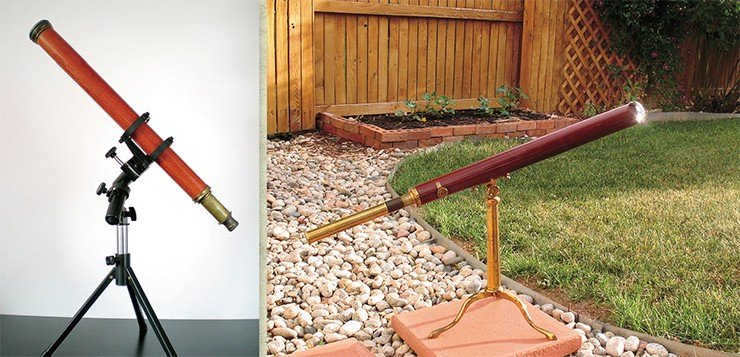

It was a significant day for numerous astronomers worldwide. In Russia, despite unfavorable weather conditions at various observation sites, over 20 researchers reported observing Lomonosov rims during the planet’s transit across the Sun’s disk, utilizing various advanced instruments. One participant even proposed a special toast on the astronomy.ru forum: “Cheers to the navel!”
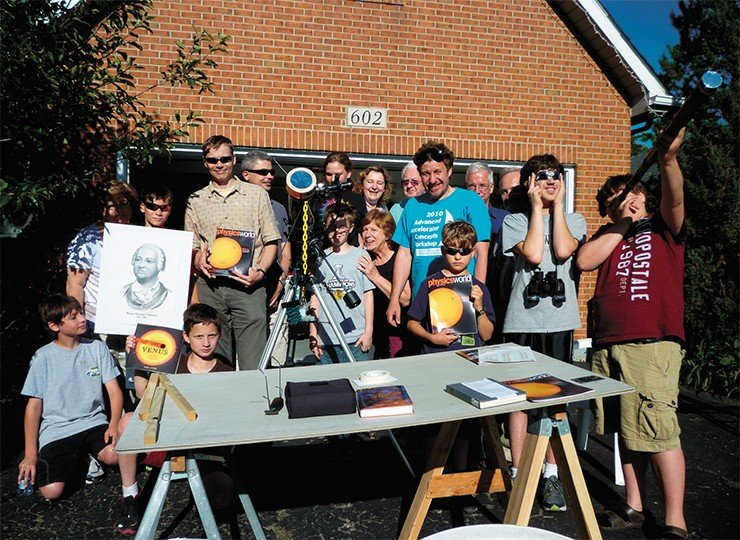
Lomonosov M. V. Complete Works. Moscow; St. Petersburg, Volume 4, pages 367-368.
Lomonosov M. V. The observation of the Venus phenomenon on the Sun at the St. Petersburg Imperial Academy of Sciences on May 26, 1761. [St. Petersburg, Tip.Akad.nauk, 1761].
Xanfomaliti L. V. Venus as a natural laboratory for the study of life in high temperatures: about the events on the planet on March 1, 1982 // Astronomical Bulletin. 2012. Vol. 46. No. 1. p. 44.
Tyulichev D.V. The book publishing activities of the St. Petersburg Academy of Sciences and M.V. Lomonosov. St. Petersburg, 1988.
Carrer d'Ancoss E. The Empress and the Abbot: The Unpublished Literary Duel between Catherine II and Abbot Chappe d'Atroche / Translated from French by O. A. Pavlovskaya. Moscow: Olma-Press, 2005.
We would like to express our gratitude to Y. L. Mentsin, A. M. Cherepashchuk (GAISH), Y. K. Chistov, M. F. Hartanovich, and K. M. Vozdigan (MAE RAS), A. R. Nesterenko (NSU), M. S. Aksentyeva (UVN), R. Z. Sagdeev (University of Maryland), and R. C. Sagdeev (University of Maryland). C. Crease (SUNY) for their invaluable consultations and assistance in the process of selecting the materials for this research.
: 16 Aug 2012, In Search of the Beginning of All Beginnings, Vol. 45, No. 3
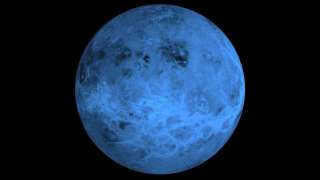
Venus, the neighboring planet of Earth, is the second closest planet to the Sun. However, prior to the era of space exploration, very little was known about Venus due to its completely obscured surface hidden beneath thick clouds. These clouds are composed of sulfuric acid, which causes a strong reflection of light.
As a result, the visible surface of Venus cannot be observed. Venus has an atmosphere that is 100 times denser than Earth’s and is primarily made up of carbon dioxide.
Venus receives no more sunlight than the Earth receives from the Moon on a clear night.
Nevertheless, the Earth’s atmosphere is subject to intense heating by the Sun, resulting in a perpetual state of extreme heat, where temperatures can reach up to 500 degrees Celsius. The primary cause of this significant warming phenomenon can be attributed to the greenhouse effect, which is fueled by the presence of carbon dioxide in the atmosphere.
Unveiling the past
Even in a small telescope, it is easy to observe and track the visible phase shift of Venus’ disk. Galileo first observed these phase shifts in 1610. On June 6, 1761, M.V. Lomonosov discovered the atmosphere of Venus when the planet passed in front of the Sun. Astronomers around the world eagerly anticipated this cosmic event, which had been predicted in advance. However, it was only Lomonosov who focused on the appearance of a “thin, hair-like glow” around Venus at the moment of contact with the Sun’s disk. Lomonosov provided a correct scientific explanation for this phenomenon, attributing it to the refraction of solar rays in Venus’ atmosphere.
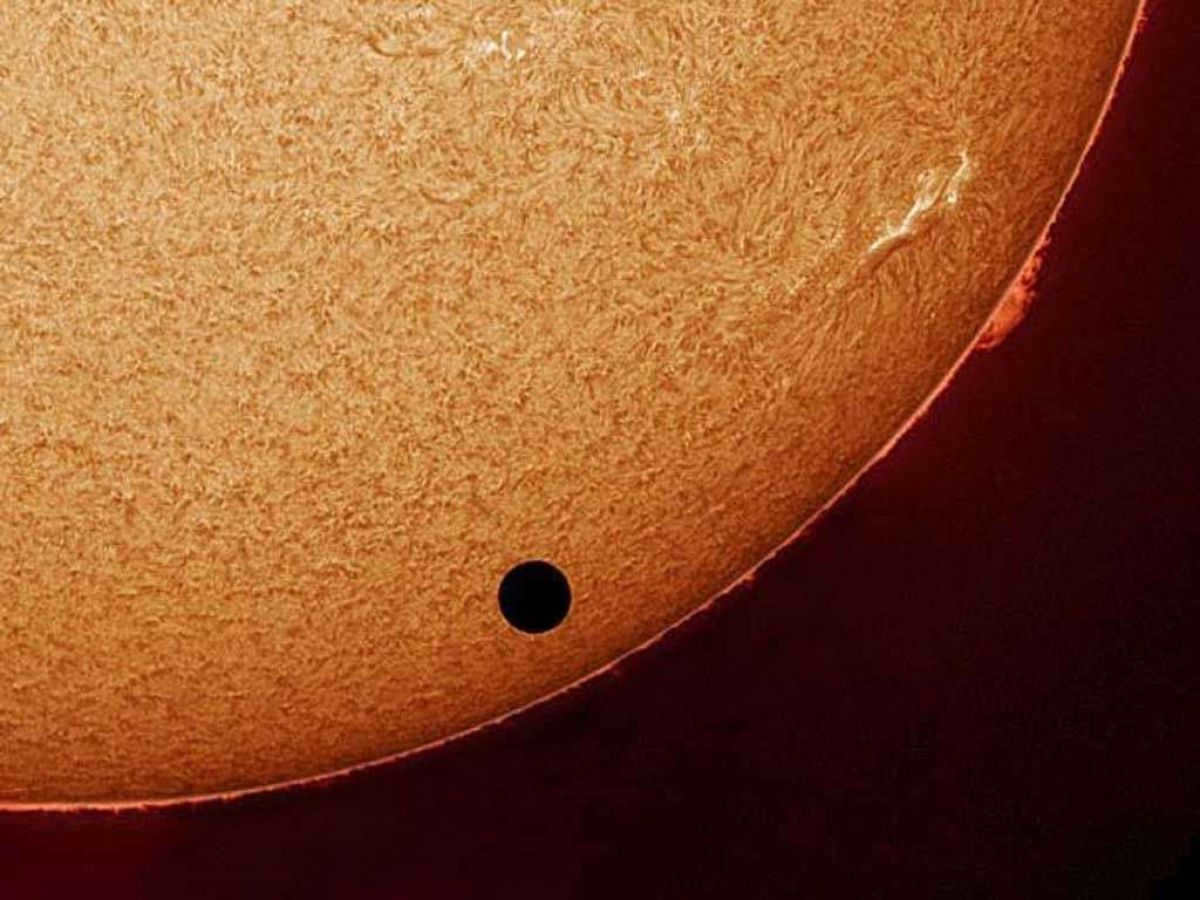
“According to Lomonosov, Venus has a light atmosphere surrounding it, similar to, but not more than, the atmosphere surrounding our own Earth.”
Key Features
- Distance from the Sun: 108,200,000 kilometers
- Length of Day: 117d 0h 0m
- Mass: 4.867E24 kg (0.815 Earth mass)
- Acceleration due to gravity: 8.87 m/s²
- Orbital Period: 225 days
The atmospheric pressure on Venus is equivalent to 92 times that of Earth. This means that every square centimeter experiences the weight of a gas column that is 92 kilograms in mass.
Venus has a unique rotation compared to other planets in our solar system. While most planets rotate from west to east, Venus rotates from east to west. In fact, only one other planet, Uranus, shares this unusual rotation. Venus takes 243 Earth days to complete one full rotation on its axis. However, a year on Venus, which is equivalent to one orbit around the sun, only takes 224.7 Earth days. This means that a day on Venus is actually longer than a year on the planet! Despite this long day, Venus does experience periods of day and night, although it does not have the same change of seasons that we observe on Earth.
Investigation
In the present era, Venus’s terrain is being explored through the use of spacecraft and radio waves. Consequently, it has been observed that a significant portion of the planet’s surface is comprised of undulating plains. The soil and the atmosphere above it appear in a vibrant orange hue. Furthermore, the planet’s exterior is adorned with a multitude of craters resulting from the impact of sizable meteorites. These craters can span an impressive diameter of up to 270 kilometers! Additionally, it is widely acknowledged that Venus boasts an extensive collection of tens of thousands of volcanoes. Recent investigations have unveiled that a portion of these volcanoes remain active.
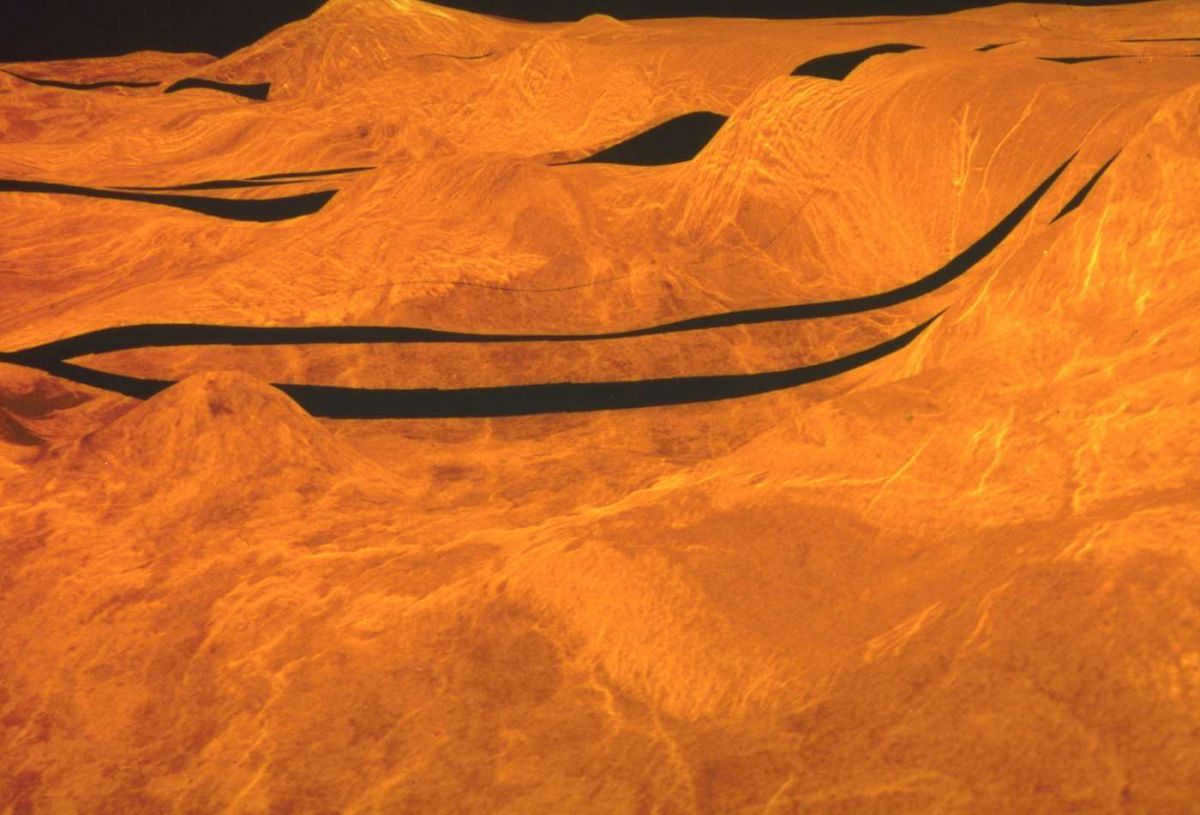
Venus – the Morning Star and the Evening Star, is the third most luminous object in our celestial sphere. It is known as the Morning Star and the Evening Star because it appears brightest just before sunrise and sunset. In ancient times, people believed that the morning and evening manifestations of Venus were distinct celestial bodies. Venus outshines even the brightest stars in both the morning and evening sky.
Venus is a solitary planet, devoid of any natural satellites. It is the sole planet in our solar system that bears the name of a female deity, while the other planets are named after male gods.
Lomonosov was the first to establish the fundamental principles of the kinetic theory of gases. Through his corpuscular-kinetic theory of heat, M.V. Lomonosov made early predictions and assumptions that would later inform the development of atomic and material structure theories.
In 1748, M.V. Lomonosov achieved the construction and outfitting of Russia’s inaugural chemical laboratory based on his own designs. At the Academy of Sciences, he embarked on the analysis of various ores and minerals. Over the course of more than 4 thousand experiments, he also pioneered the production technology for colored transparent and opaque (smalt) glasses.
In 1753, Lomonosov initiated the construction of a factory dedicated to producing colored glass products. The Ust-Ruditskaya factory was an innovative art-industrial enterprise in 18th-century Russia, utilizing machinery designed by the renowned scientist.
On May 26 (June 6), 1761, while observing the transit of Venus across the Sun, Mikhail Lomonosov made a remarkable discovery – he found that Venus possesses an atmosphere, which appears to be denser than that of Earth. This groundbreaking revelation alone would have secured Lomonosov’s name in history. The identification of an atmosphere on Venus stands as a momentous event in the annals of astronomy, not only bearing importance for cosmology but also establishing the groundwork for astrophysics as a scientific discipline.
An image of Lomonosov in a chemical laboratory, depicted by the artist N. Nagovitsyn in 1958.
In the early 1750s, Lomonosov became fascinated with the art of creating mosaics, glassware, and beads. He brought back the ancient tradition of mosaics to Russia and established a workshop where forty mosaics were crafted. Today, twenty-three of these mosaics still exist.
Lomonosov also made significant contributions to various scientific fields, including the study of light, photometry, astrophysics, and the scientific principles behind color vision.
© 2007 Department of Education and Science of the Administration of the Arkhangelsk region
© 2007 Interregional Lomonosov Foundation
© 2007-2010 development and design: Department of Multimedia and Internet Technologies of the Lomonosov Moscow State University Information Center.
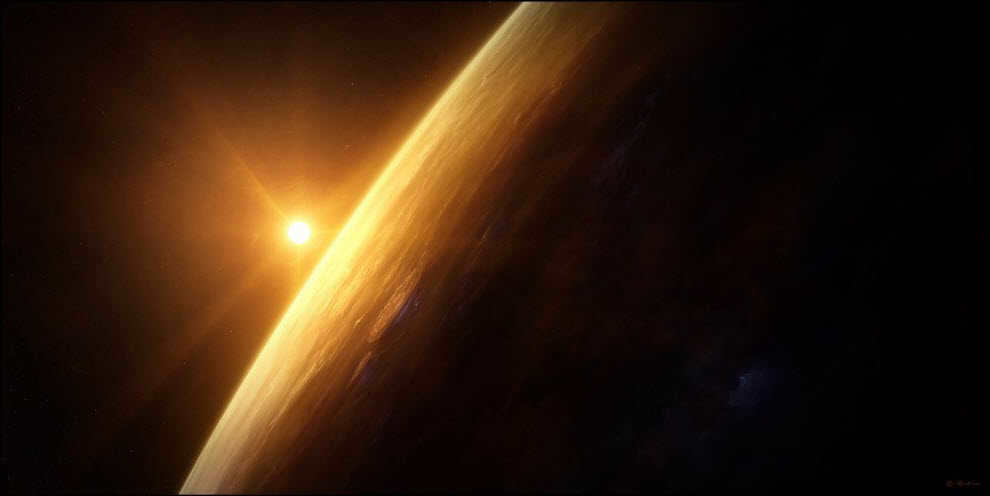
Venus, the nearest neighbor of Earth in our solar system, appears as a luminous star in the night sky, shining brightly among the celestial bodies. Similar to our own planet, Venus revolves around the Sun, but at a closer proximity. The distance between Venus and Earth is merely 0.28 astronomical units, equivalent to approximately 41 million kilometers, which is relatively small in cosmic terms. As a result, there are occasions when the transit of Venus can be observed, as it passes through space between our planet and the Sun. During such events, the human eye can witness two distinct disks: the vast solar disk and the smaller disk of Venus.
The orbit of Venus is peculiar in that it takes the shape of a perfect circle, which is uncommon among the other planets in our solar system, as most of them have elliptical orbits. Furthermore, Venus rotates in a clockwise direction, which is also atypical compared to other planets (except for Uranus). These distinct characteristics result in the absence of seasons on Venus, with perpetual cloud cover. For a long time, astronomers have been intrigued by the question of whether Venus possesses an atmosphere.
In 1761, calculations revealed that Venus would transit across the face of the Sun, briefly positioning itself between the Earth and the Sun. Naturally, this celestial event captured the interest of M. V. Lomonosov and his team, which included Stepan Rumovsky (a student of the renowned mathematician Leonard Euler) and Nikita Panin (an observer from the Academy of Sciences).
Lomonosov himself actively participated in the exploration of a unique celestial event. On June 6 (May 26), 1761, he conducted highly successful astronomical observations, utilizing a regular telescope equipped with smoked glass. Lomonosov meticulously recorded all of his observations in his personal diary.
While numerous experienced astronomers from different countries observed this rare natural phenomenon, none of them were able to perceive what the Russian scientist had discovered.
It is possible that Lomonosov had been anticipating this breakthrough for quite some time. He was well ahead of his European counterparts, as it took another 30 years for German astronomer I. Schroeter and English astronomer W. Herschel to independently detect the atmosphere once again. Herschel managed to identify the atmosphere of Venus for a second time. These astronomers utilized more advanced optical instruments, which Lomonosov did not require, as he already knew the outcome in advance.
Thanks to the advancements in modern automated vehicles, scientists have once again been able to confirm the existence of an atmospheric shell surrounding Venus. The planet boasts a highly dense atmosphere, with a composition of 97% carbon dioxide (CO2). Due to the intense greenhouse effect, temperatures on the surface of Venus can soar up to a scorching 500 degrees Celsius. The distinctive orange-yellow clouds that envelop Venus are extremely arid, devoid of any form of precipitation. However, lightning and thunderstorms frequently illuminate and reverberate across this fiery world. These inhospitable conditions make it highly improbable for life, even in its most primitive form, to originate on Venus. Nonetheless, the discovery made by M.V. Lomonosov well before the age of scientific and technological revolution remains of great significance.
Kepler was the first to predict the passage of Venus across the Sun’s disk, setting the date for December 7, 1631. This unique event happens at regular intervals of 105.5 years, 8 years, 121.5 years, 8 years, and then another 105.5 years, and so on. When Venus transits, it appears as a tiny black disc traversing the surface of the Sun.
The particular interest of astronomers from Russia and other countries in the transit of Venus across the Sun’s surface on May 26, 1761 was linked to a novel approach for determining the solar parallax, also known as the distance to the Sun. This method was proposed by the English astronomer Edmond Halley in 1691 (with a follow-up article in 1716). To employ this technique, it was necessary to accurately measure the time interval between Venus’s entry onto the Sun’s surface and its final contact. Over 100 astronomers at more than 40 locations conducted observations during this transit, making it the first major international astronomical endeavor.
For instance, James Cook took part in the aforementioned expedition. On the 3rd of June, 1769, the expedition was joined by the British explorer Captain James Cook, the British botanist Joseph Banks, the British astronomer Charles Green, and the Swedish botanist Daniel Solander. They were responsible for documenting the transit of Venus on the island of Tahiti during Cook’s inaugural voyage around the world. These individuals, accompanied by a team of scientists, were appointed by the Royal Society of London with the main objective of observing the transit of Venus. The information they obtained would not only contribute to the advancement of scientific knowledge, but it would also enhance navigation by accurately determining the observer’s longitude. At that time, determining longitude was a challenging task that was not always accomplished with precision.
"Sovereigns and governments go to great lengths to support the construction and maintenance of astronomical observatories. They also reward those who possess knowledge in this field and dispatch them to far-off lands to observe rare celestial events. One such event was the recent transit of Venus across the Sun. Astronomers from France and England, in addition to their European counterparts, were sent to various parts of the world to satisfy curiosity and expand our understanding of the universe. The Imperial Academy of Sciences, acting under the highest command of H.I.H., sent Mr. Councillor and Astronomy Professor Popov and Mr. Mathematics Adjunct Rumovsky from the Governing Senate to the remote lands of Siberia. They were provided with double salaries, as well as all necessary supplies and instruments, to ensure their successful observation of this remarkable phenomenon".
The complete cycle of the phenomenon takes 243 years, during which there are four occurrences of Venus passing across the surface of the sun. Two of these transits occur in winter, with an interval of 8 years. The previous winter transits took place on December 9, 1874, and December 6, 1882. After that, there is a long gap of 121.5 years, followed by two summer transits, also with an 8-year interval. The most recent observation of the closest planet to Earth passing by occurred on June 8, 2004. The next pair of transits will happen in the years 2117 and 2125.
These events are fascinating occurrences in the field of astronomy. As M. V. Lomonosov once said, “Great minds can give birth to Plato and quick-witted individuals can give birth to Newton in the Russian land.”
It has been 3716 days since the beginning of the year 2012.
M. V. Lomonosov’s Impact on Astronomy and Astrophysics!
Through the lens of science, M. V. Lomonosov delved into the enigmas of matter and illuminated the path to truth. Science and experience serve as mere tools, as means of acquiring knowledge for the mind.
Of the many fields that Lomonosov contributed to, astronomy stands out as a shining example. One of Lomonosov’s most significant achievements in this realm was his groundbreaking discovery that Venus possesses an atmosphere. This discovery came to light during his observations of Venus passing across the Sun’s surface on May 26 (June 6), 1761.

Therefore, the year 2011 not only commemorates the 300th anniversary of Lomonosov’s birth but also the 250th anniversary of his significant astronomical breakthrough.
On May 27, Lomonosov commenced the composition of an article titled “The Observation of Venus on the Sun at the St. Petersburg Imperial Academy of Sciences on May 26, 1761”. This article incorporated not only his own observations but also the recorded observations of A.D. Krasilnikov and N.G. Kurganov. In this publication, in addition to providing a detailed account of the “precise astronomical observations”, Lomonosov mentions that he was also “intrigued by physical observations”. He made these observations using a small tube (measuring 4.5 feet or 135 cm in length) with a strong chromatic aberration, and viewed the phenomenon through “lightly smoked glass”. The images produced by this setup were of high quality only near the center of the field of view.
Lomonosov’s primary objective was “to note the beginning and end of the phenomenon” and to concentrate all his visual faculties on that task. He allowed himself rest during the other moments of Venus’ passage.
Initially, Lomonosov critiques the inaccuracy of Epinus’s ephemeris, noting that Venus entered the Sun’s disk 40 minutes later than predicted. He then proceeds to provide a renowned account of Venus’s atmosphere. Lomonosov observes that the solar edge appeared somewhat clouded when Venus approached it, and similarly became blurred as Venus moved away from the disk. “After waiting for Venus’s entry into the Sun, which was delayed by approximately 40 minutes according to the ephemerides, I finally witnessed the expected solar edge becoming indistinct and somewhat obscured, whereas it had previously been clear and uniform throughout.” Furthermore, “When Venus’s front edge began to approach the solar edge, coming within about a tenth of Venus’s diameter, a protuberance (refer to the figure below) appeared on the Sun’s edge, which became more prominent as Venus approached (see figures 3 and 4). LS represents the edge of the Sun, while mm depicts the Sun’s convexity in relation to Venus. Shortly thereafter, this protuberance disappeared, and Venus suddenly appeared without an edge (see figure 5); np indicates a small yet noticeable segment. The complete exit, or the final contact of Venus’s back edge with the Sun during the exit, also exhibited some detachment and the solar edge appeared obscured.”

M.V. Lomonosov made drawings depicting his observations of the transit of Venus across the Sun’s surface on May 26, 1761.
The presence of a faint ring around Venus, partially overlapping with the Sun’s surface, was named the “Lomonosov phenomenon”. This phenomenon is a result of the refraction of sunlight in Venus’ upper atmosphere.
Lomonosov provides an explanation for this phenomenon: “This demonstrates nothing else but the refraction of sunlight in the atmosphere of Venus.”
The identification of Venus’s atmosphere held significant significance for proponents of the Copernican stance within Russia.
Moreover, Lomonosov’s contribution extended beyond the revelation of Venus’s atmosphere, encompassing his crucial involvement in coordinating and arranging various astronomical, geodetic, and geographic expeditions.


Lomonosov revolutionized the study of astronomy by introducing numerous scientific terms that are still widely utilized today. His contributions include elucidating the laws governing planetary motion, understanding the Earth’s axis, exploring the concept of the horizon, investigating the refraction of rays, examining the phenomenon of a full moon, delineating constellations, studying the composition of the atmosphere, and much more.
ASTONISHING DISCOVERIES.
Traversing the Sun’s disk

As an inner planet in relation to Earth, Venus provides its inhabitants with the unique opportunity to witness its transit across the Sun’s disk. When viewed through a telescope from Earth, Venus appears as a small black disk against the backdrop of the massive Sun. This celestial event is extremely rare and can only be observed from Earth’s surface a few times every couple of centuries. There are typically four transits, occurring in December and June, and the next one is set to take place on June 6, 2012.

It is intriguing to note that when the disk of Venus approaches the outer edge of the Sun’s disk or is at a distance from it, astronomers have observed a second effect. This phenomenon, originally discovered by M. V. Lomonosov, has yet to be fully explained, but it is likely a result of the planet’s atmosphere acting as a mirror and reflecting the Sun’s light. This effect is most pronounced when Venus is in close proximity to the Sun and occurs at small slip angles. The scientist describes this phenomenon as follows:
In the middle of the 18th century, the first Russian scientist-encyclopedist Mikhail Vasilyevich Lomonosov made a noteworthy contribution to the formation of our modern understanding of the universe. Lomonosov’s impact on the advancement of natural science was primarily characterized by profound scientific and philosophical generalizations and the advancement of scientific research methods. Additionally, he expressed a desire to utilize the advancements of science for the economic growth of Russia.
Lomonosov’s fascination with celestial phenomena began in his childhood, when he witnessed the awe-inspiring display of the polar lights. His wide range of interests and his ability to analyze the interconnectedness of phenomena led him to make numerous important discoveries, inventions, and conclusions in the field of astronomy. Surpassing the knowledge of his time by centuries, he was one of the few contemporaries who delved into the physical nature of celestial objects, guided by the belief in the unity of the Earth and the celestial bodies. Lomonosov put forth several accurate ideas of astrophysical nature.
During his studies with his friend Academician G.W. Richman, Lomonosov proposed an intriguing hypothesis about the origin of atmospheric electricity, suggesting that it arises from the friction between rising and falling warm and cold air currents (a notion that aligns well with modern perspectives).

Even in our era, the profound scientific intuition and poetic expression of Lomonosov can be seen in his depiction of the physical essence of the Sun. The essence of the Sun.
He was a trailblazer in various fields of knowledge and made significant contributions to Russian science. Despite being born into a family of fishermen along the shores of the White Sea, his brilliance knew no bounds. It would take several volumes to fully chronicle all of his scientific achievements. Presented below are just a handful of his noteworthy accomplishments, which laid the groundwork for the bright future of domestic science.
Lomonosov, who had witnessed the northern lights during his childhood, was the pioneer scientist to investigate this natural phenomenon and provide a plausible interpretation for it.
Uncovering the Atmosphere of Venus
In a momentous event on June 6, 1761, Mikhail Lomonosov made a groundbreaking discovery – the transit of Venus as it crossed the radiant face of the Sun.
The Evolution of the Particle-Kinetic Theory
Manufacturing solid mercury
Advancement in the concepts of physical chemistry
The evolution of economic geography principles
The study of glass and the making of mosaics
The study of glass originated at the crossroads of physics and chemistry, evolving into a realm of physical and chemical exploration within the discipline of physical chemistry.





